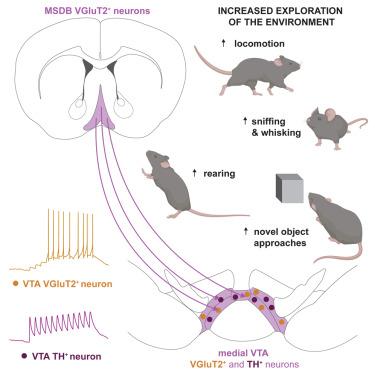Our official English website, www.x-mol.net, welcomes your feedback! (Note: you will need to create a separate account there.)
A septal-ventral tegmental area circuit drives exploratory behavior
Neuron ( IF 16.2 ) Pub Date : 2024-01-23 , DOI: 10.1016/j.neuron.2023.12.016 Petra Mocellin , Oliver Barnstedt , Kevin Luxem , Hiroshi Kaneko , Silvia Vieweg , Julia U. Henschke , Dennis Dalügge , Falko Fuhrmann , Anna Karpova , Janelle M.P. Pakan , Michael R. Kreutz , Sanja Mikulovic , Stefan Remy
Neuron ( IF 16.2 ) Pub Date : 2024-01-23 , DOI: 10.1016/j.neuron.2023.12.016 Petra Mocellin , Oliver Barnstedt , Kevin Luxem , Hiroshi Kaneko , Silvia Vieweg , Julia U. Henschke , Dennis Dalügge , Falko Fuhrmann , Anna Karpova , Janelle M.P. Pakan , Michael R. Kreutz , Sanja Mikulovic , Stefan Remy

|
To survive, animals need to balance their exploratory drive with their need for safety. Subcortical circuits play an important role in initiating and modulating movement based on external demands and the internal state of the animal; however, how motivation and onset of locomotion are regulated remain largely unresolved. Here, we show that a glutamatergic pathway from the medial septum and diagonal band of Broca (MSDB) to the ventral tegmental area (VTA) controls exploratory locomotor behavior in mice. Using a self-supervised machine learning approach, we found an overrepresentation of exploratory actions, such as sniffing, whisking, and rearing, when this projection is optogenetically activated. Mechanistically, this role relies on glutamatergic MSDB projections that monosynaptically target a subset of both glutamatergic and dopaminergic VTA neurons. Taken together, we identified a glutamatergic basal forebrain to midbrain circuit that initiates locomotor activity and contributes to the expression of exploration-associated behavior.
中文翻译:

间隔-腹侧被盖区回路驱动探索行为
为了生存,动物需要平衡探索动力和安全需求。皮层下回路在根据外部需求和动物内部状态启动和调节运动方面发挥着重要作用;然而,如何调节运动的动机和开始仍然很大程度上尚未解决。在这里,我们展示了从内侧隔膜和布罗卡对角线带(MSDB)到腹侧被盖区(VTA)的谷氨酸通路控制小鼠的探索性运动行为。使用自我监督的机器学习方法,我们发现当这种投影被光遗传学激活时,探索性动作的比例过高,例如嗅探、搅拌和饲养。从机制上讲,这一作用依赖于谷氨酸能 MSDB 投射,该投射单突触靶向谷氨酸能和多巴胺能 VTA 神经元的子集。综上所述,我们发现了一个谷氨酸能基底前脑到中脑回路,它启动运动活动并有助于探索相关行为的表达。
更新日期:2024-01-23
中文翻译:

间隔-腹侧被盖区回路驱动探索行为
为了生存,动物需要平衡探索动力和安全需求。皮层下回路在根据外部需求和动物内部状态启动和调节运动方面发挥着重要作用;然而,如何调节运动的动机和开始仍然很大程度上尚未解决。在这里,我们展示了从内侧隔膜和布罗卡对角线带(MSDB)到腹侧被盖区(VTA)的谷氨酸通路控制小鼠的探索性运动行为。使用自我监督的机器学习方法,我们发现当这种投影被光遗传学激活时,探索性动作的比例过高,例如嗅探、搅拌和饲养。从机制上讲,这一作用依赖于谷氨酸能 MSDB 投射,该投射单突触靶向谷氨酸能和多巴胺能 VTA 神经元的子集。综上所述,我们发现了一个谷氨酸能基底前脑到中脑回路,它启动运动活动并有助于探索相关行为的表达。



























 京公网安备 11010802027423号
京公网安备 11010802027423号